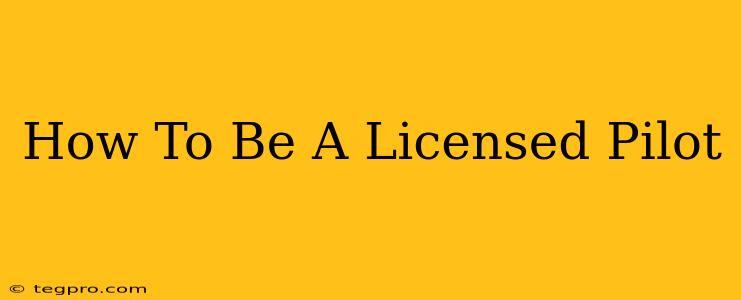So, you dream of soaring through the skies, feeling the wind beneath your wings, and having the freedom to explore the world from a unique perspective? Becoming a licensed pilot is a challenging yet incredibly rewarding journey. This comprehensive guide will walk you through the steps necessary to achieve your dream and earn your pilot's license.
Understanding the Different Pilot Licenses
Before you begin, it's crucial to understand the different types of pilot licenses available. The most common are:
-
Sport Pilot License: This license allows for recreational flying in light sport aircraft, with limitations on passenger capacity and aircraft complexity. It's a great entry point for those wanting to experience flying without the extensive training required for other licenses.
-
Private Pilot License (PPL): This is the most common license for recreational flying. With a PPL, you can fly for personal enjoyment, carry passengers, and even fly across countries (with proper planning and flight following).
-
Commercial Pilot License (CPL): This license allows you to fly for compensation or hire. This opens doors to careers as a flight instructor, airline pilot (after further training), or other aviation-related jobs.
-
Airline Transport Pilot License (ATPL): This is the highest level of pilot certification and is required to captain an airliner. The path to an ATPL involves significant flight hours and rigorous training.
Steps to Obtaining Your Private Pilot License (PPL)
This section focuses on obtaining a PPL, as it's the most common starting point for aspiring pilots.
1. Medical Certificate: The First Hurdle
Before you even start flight training, you'll need a medical certificate from an Aviation Medical Examiner (AME). The requirements for a medical certificate vary depending on the type of license you're seeking. Schedule your medical exam early – any underlying health conditions could delay the process.
2. Finding a Flight School and Instructor
Choosing the right flight school and instructor is critical. Look for a reputable school with experienced instructors, good reviews, and a well-maintained fleet of aircraft. Consider factors like location, cost, and scheduling flexibility. A good instructor will tailor their teaching to your learning style and provide constructive feedback.
3. Ground School: Laying the Foundation
Ground school covers the theoretical aspects of flying, including meteorology, navigation, aircraft systems, regulations, and aerodynamics. Many flight schools offer ground school courses, but you can also study independently using online resources, textbooks, or self-study programs. A solid understanding of these theoretical concepts is essential for safe and efficient flight.
4. Flight Training: Putting Theory into Practice
This is where the real fun begins! Flight training involves hands-on instruction in a variety of maneuvers and procedures. Expect to learn everything from takeoff and landing to navigation, emergency procedures, and cross-country flights. The number of flight hours required varies, but expect to accumulate at least 40 hours of flight time for a PPL.
5. Written Exam: Testing Your Knowledge
Once you've completed a sufficient amount of ground school and flight training, you'll be ready for the written exam. This exam covers the material you've learned in ground school and assesses your understanding of aviation regulations and procedures. Thorough preparation is crucial for success.
6. Checkride: Demonstration of Skills
The final step is the checkride, which is a practical examination conducted by a Designated Pilot Examiner (DPE). The DPE will assess your flight skills, knowledge, and ability to handle various scenarios. This is a rigorous test, so practice and preparation are key. Passing the checkride signifies you have met all the requirements and are ready to receive your pilot's license!
Beyond the PPL: Furthering Your Aviation Career
Once you've earned your PPL, the possibilities are endless! You can pursue further ratings and certifications, such as an instrument rating (IR), commercial pilot license (CPL), or even an airline transport pilot license (ATPL). Each step requires additional training and flight hours, but opens up new opportunities and adventures in the world of aviation.
Key Considerations:
- Cost: Flight training is an investment. Factor in the cost of flight lessons, ground school, medical exams, and the licensing fees themselves.
- Time Commitment: Becoming a pilot requires dedication and time. Be prepared to invest significant time in ground school and flight training.
- Physical and Mental Fitness: Flying requires good physical and mental health. Maintain a healthy lifestyle and practice good stress management.
Becoming a licensed pilot is a significant achievement. With dedication, hard work, and a passion for aviation, you can turn your dream into a reality. Soar high!

